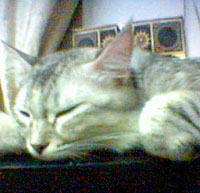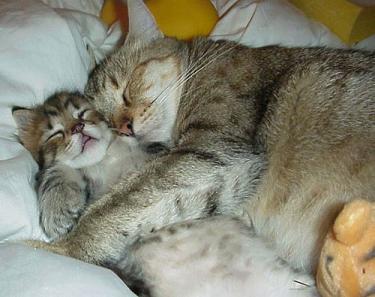NATURAL
CAT BEHAVIOUR
Sleeps
and Naps: Feline Style
Cats are the world's
best sleepers. They slumber away about 60% of their lives--16 hours
out of 24. At this rate a nine-year old cat has been awake for only
about three years!
Since cats are so efficient at obtaining their  protein-rich
food, they have plenty of time to rest up for the next hunting trip
(or visit to the kitchen). A typical feline day includes over fifteen
hours of sleeping, and dozing, four to six hours of grooming and
playing, with hunting, eating and exploring making up the rest of
the day. There are three types of adult feline sleep: the brief
nap, the longer light sleep, and the deep sleep. A napping cat is
on "radar patrol", scanning the environment for any small
sound. The periods of light sleep and deep sleep alternate. When
Kitty settles down for more than a brief nap, the phase of light
sleep lasts for about a half hour. Then, for six to seven minutes,
he experiences deep sleep. At this point the cat's body protein-rich
food, they have plenty of time to rest up for the next hunting trip
(or visit to the kitchen). A typical feline day includes over fifteen
hours of sleeping, and dozing, four to six hours of grooming and
playing, with hunting, eating and exploring making up the rest of
the day. There are three types of adult feline sleep: the brief
nap, the longer light sleep, and the deep sleep. A napping cat is
on "radar patrol", scanning the environment for any small
sound. The periods of light sleep and deep sleep alternate. When
Kitty settles down for more than a brief nap, the phase of light
sleep lasts for about a half hour. Then, for six to seven minutes,
he experiences deep sleep. At this point the cat's body relaxes and he appears to be dreaming (twitching and quivering).
After the deep sleep, the adult cat then returns to another bout
of thirty minutes of light sleep until he eventually wakes up. When
choosing a site for your cat's bed, keep in mind the feline need
for warmth and security (high and protected). It has been observed
that the temperature of the room is a determining factor in the
sleeping cat's body position. At less than 55 degrees F., the cat
is curled up with his head tucked into his body. As the temperature
increases, the cat's sleeping position opens up. At over 70 degrees
F., the cat is uncurled with paws out in front. Upon waking, the
supple cat usually takes a few minutes to stretch and restore his
circulation. A yawn or two later, a quick face wash, and watch out!--he's
ready for action.
relaxes and he appears to be dreaming (twitching and quivering).
After the deep sleep, the adult cat then returns to another bout
of thirty minutes of light sleep until he eventually wakes up. When
choosing a site for your cat's bed, keep in mind the feline need
for warmth and security (high and protected). It has been observed
that the temperature of the room is a determining factor in the
sleeping cat's body position. At less than 55 degrees F., the cat
is curled up with his head tucked into his body. As the temperature
increases, the cat's sleeping position opens up. At over 70 degrees
F., the cat is uncurled with paws out in front. Upon waking, the
supple cat usually takes a few minutes to stretch and restore his
circulation. A yawn or two later, a quick face wash, and watch out!--he's
ready for action.
|



![]()
![]()
![]()
 protein-rich
food, they have plenty of time to rest up for the next hunting trip
(or visit to the kitchen). A typical feline day includes over fifteen
hours of sleeping, and dozing, four to six hours of grooming and
playing, with hunting, eating and exploring making up the rest of
the day. There are three types of adult feline sleep: the brief
nap, the longer light sleep, and the deep sleep. A napping cat is
on "radar patrol", scanning the environment for any small
sound. The periods of light sleep and deep sleep alternate. When
Kitty settles down for more than a brief nap, the phase of light
sleep lasts for about a half hour. Then, for six to seven minutes,
he experiences deep sleep. At this point the cat's body
protein-rich
food, they have plenty of time to rest up for the next hunting trip
(or visit to the kitchen). A typical feline day includes over fifteen
hours of sleeping, and dozing, four to six hours of grooming and
playing, with hunting, eating and exploring making up the rest of
the day. There are three types of adult feline sleep: the brief
nap, the longer light sleep, and the deep sleep. A napping cat is
on "radar patrol", scanning the environment for any small
sound. The periods of light sleep and deep sleep alternate. When
Kitty settles down for more than a brief nap, the phase of light
sleep lasts for about a half hour. Then, for six to seven minutes,
he experiences deep sleep. At this point the cat's body relaxes and he appears to be dreaming (twitching and quivering).
After the deep sleep, the adult cat then returns to another bout
of thirty minutes of light sleep until he eventually wakes up. When
choosing a site for your cat's bed, keep in mind the feline need
for warmth and security (high and protected). It has been observed
that the temperature of the room is a determining factor in the
sleeping cat's body position. At less than 55 degrees F., the cat
is curled up with his head tucked into his body. As the temperature
increases, the cat's sleeping position opens up. At over 70 degrees
F., the cat is uncurled with paws out in front. Upon waking, the
supple cat usually takes a few minutes to stretch and restore his
circulation. A yawn or two later, a quick face wash, and watch out!--he's
ready for action.
relaxes and he appears to be dreaming (twitching and quivering).
After the deep sleep, the adult cat then returns to another bout
of thirty minutes of light sleep until he eventually wakes up. When
choosing a site for your cat's bed, keep in mind the feline need
for warmth and security (high and protected). It has been observed
that the temperature of the room is a determining factor in the
sleeping cat's body position. At less than 55 degrees F., the cat
is curled up with his head tucked into his body. As the temperature
increases, the cat's sleeping position opens up. At over 70 degrees
F., the cat is uncurled with paws out in front. Upon waking, the
supple cat usually takes a few minutes to stretch and restore his
circulation. A yawn or two later, a quick face wash, and watch out!--he's
ready for action.